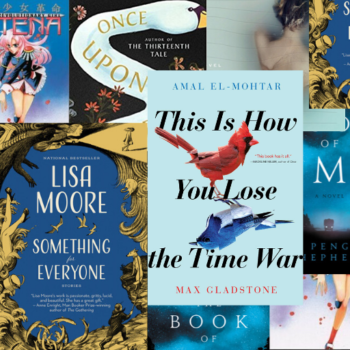
Rereading The Summer Tree: Looking Back and Looking Forward
- Posted by Augur Blog
- On January 20, 2020
- 0 Comments
- fantasy, feminism, guy gavriel kay
By Marcie McCauley
It was the year we would see how right George Orwell had been: 1984. Madonna’s “Like a Virgin” and Tina Turner’s “Private Dancer” were playing on cassette. Swing Shift and Supergirl played in single-screen movie theatres. And Guy Gavriel Kay’s debut novel, The Summer Tree, beckoned readers to Fionavar.
Feminists on the Shelf in 1984
True, 1984 also saw Audre Lorde’s Sister Outsider and bell hooks’s Feminist Theory published, as well as Suzette Haden Elgin’s Mother Tongue and Octavia Butler’s third Patternmaster novel. Meanwhile Diana Wynne Jones, Robin McKinley and Tamora Pierce were writing for younger readers, and Ursula K. Le Guin’s Earthsea sequence was released in an omnibus (with four volumes and fewer girls).
But these options were not available in the small-town Ontario libraries I frequented. Neither were Monica Hughes, O.R. Melling or Karleen Bradford. And the chain bookstores I visited, on trips to the city, displayed Piers Anthony and David Eddings; when Marion Zimmer Bradley’s books appeared, the bodacious women on their covers were as strange to me as halflings.
Girls Riding Horses with Horns
Dorothy’s adventures in Oz were what a girl could hope for during my younger SFF-reading years. When I saw the cover of The Summer Tree, with a girl riding a horned horse, I was all in. It was actually a long-haired boy, but I saw what I wanted to see: I yearned for stories in which girls could soar.
Fionavar became All the Things for me (the trilogy’s second and third volumes were published in 1986 and 1987). And I continued to recommend Guy Gavriel Kay’s books — faster than I could read them, until, with the news of his 2019 publication, A Brightness from Long Ago, I wondered whether what I remembered as feminist storytelling seemed ground-breaking only because my options were limited.
Who’s at the Heart of It All?
The term ‘high fantasy’ wasn’t in my lexicon when I first travelled to Fionavar. Nor did I recognize the archetypal tale at its root (no spoilers!). But I would have intuitively looked for the “haggard man with the wispy, snow-white beard” and expected him to be at the heart of the adventure.
Indeed, that was true of this story’s fifth– and sixth-century roots. And still true when the 12th-century storytellers added a woman to the story, an object of desire. By the mid-20th century, the story had been retold so often, it was even at the movies, but this woman’s role only grew, it never developed. But as a girl, I had no context for measuring Kay’s departures: I only recognized a change.
Passing the Bechdel Test
Anyone can see that two women open the first chapter of The Summer Tree. The work also passes the Bechdel Test, although the criteria weren’t defined until 1985. Multiple women influence the story: not as exceptions, but as the rule. There is no single mode of acceptable female behavior and there are as many same-sex alliances as there are conflicts.
Women face unique risks and some characters objectify them. One observes “undeniably pert serving-women,” and describes a central female character as “a peach to nibble” (she rejects his advances).
Violence is perpetrated against some women, too. Even in powerlessness, however, the women in these stories refuse to inhabit a state of victimhood. Their ultimate power is agency: “We have a choice…we are not slaves, even to our gifts.”
Complex and Varied Characters
This emphasis on freedom continues in Kay’s newest novel, too. Though narrated by an older man reflecting on his life, female characters quickly occupy centre stage. Both female and male characters are complex and varied: biology does not dictate behavior and members of both sexes challenge stereotypes.
There are as many different expectations of feminism as there are expectations of a good read. And, like one of the characters in Kay’s newest novel, I embrace that complexity. It’s a “good thing…that there [are] women working to widen the world in different ways.” Against a backdrop dominated by Middle Earth and Narnia, of occasional and obedient girl characters, the female characters in the Fionavar trilogy widened my world.
For girl-me, these stories were revolutionary; they whetted my appetite for more and, in the next decade, I discovered Diana Paxson and Lois McMaster Bujold, Suzy McKee Charnas and Nicola Griffith, Elizabeth Moon and Larissa Lai.
From Occasional and Obedient, to Plentiful and Prominent
Now grown, I recognize that an insistence on equality and agency for female characters in 1984 remains remarkable in the context of traditional mythologies: just three decades before, the key story behind Fionavar had only one significant woman in it, a cookie-cutter-styled siren.
Three decades after Fionavar, writers like N.K. Jemisin, Nnedi Okorafor, Eden Robinson, Cherie Dimaline, Kij Johnson, Hiromi Goto, C.L. Polk, and Nalo Hopkinson are exploring underrepresented mythologies and widening the literary world again. Their stories are revolutionary for me as a grown reader.
Three decades from now, how revolutionary will today’s fantastical stories seem to those future readers grown, once the literary landscape has widened still farther, and they are looking back to their youthful revolutionary reading, the stories of our present-day?
Literature invites readers to explore and revisit territory as curiosity and courage ebb and flow. We can choose our own stories and inhabit wider worlds. After all, one reader’s routine read is another reader’s revolutionary read. And isn’t it what we all desire, when we are children and while we grow, as readers and as human beings: “Living a life I choose.”
MARCIE MCCAULEY lives and writes in Toronto, on the traditional territory of the Anishnaabeg, Haudenosaunee, and Huron-Wendat. She reviews for The /tƐmz/ Review, World Literature Today and The Los Angeles Review of Books and has had fiction published in Orbis (UK) and Room (Canada). She writes about writing at marciemccauley.com and about reading at buriedinprint.com.




0 Comments